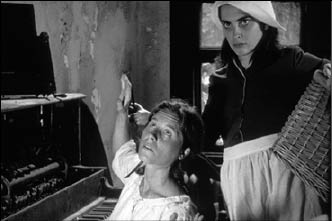Next story: Eyes Wide Shut: United 93, Hard Candy
The Nerves in Patterns on a Screen: Zoe Beloff's Charming Augustine
by Girish Shambu

From my childhood in India, I have vivid memories of my parents taking me regularly to both magic shows and the movies. The two are, in my mind, inseparably tied together. Movies, you could say, are a sort of magic—a conjuring trick of images performed with light and shadow in a darkened room. They traffic in illusion and performance.
These ideas are at the heart of work by Scottish-born filmmaker Zoe Beloff, who will be presenting her 40-minute, 3D film Charming Augustine on Saturday, April 29, at 8pm at Hallwalls. The film is inspired by photographs and texts published by an asylum in Paris in the 1880s. Augustine was a young patient who was prone to fits of hysteria. She heard voices and had hallucinatory visions. Her doctors kept transcripts of her attacks and also took accompanying photographs.
The film starts out as a sort of clinical medical document but then slowly changes into a fiction-like drama. There is a theatrical aspect to Augustine’s fits that the film is interested in exploring. Her hysteria led to the acting out of her unconscious fears and desires, and it is this performative aspect that lends itself to the cinematic. It’s a way of using cinema to make altered states visible, to capture a spell of delirium as it unfolds, as if one were recording a performance.
The film is set at an interesting point in time. In the late 19th century, pioneers like Muybridge and Marey were using cameras to conduct studies of human and animal bodies in motion, investigations that led to the birth of cinema. Augustine’s doctors used the same cameras to record not the body but instead the human mind.
Though movies had not yet been born, audiences of the day did not lack for cinema-like spectacle. Stereoscopic photography—what we call “3D”—was invented in the mid-1800s, and the magic lantern, which was the forerunner of the movie projector, had been around for much longer. Victorian ghost shows and phantasmagorias used a combination of these devices to conjure up likenesses of people. 3D slides were especially effective because live performers would interact dramatically with handpainted slides projected on a screen.
By choosing to use 3D, Beloff has filmed the story of Augustine the way it might have been filmed at the time, if cinema had existed. She has said: “My project for some time has been an attempt to awaken the past buried behind the present, behind the illusion of progress, by studying its scraps and remains, outdated buildings and fashions, the landscape of the everyday that has been discarded, overlooked.”
Also on the program are two short films that influenced Beloff. In D.W. Griffith’s The Painted Lady (1912), Blanche Sweet plays a woman afflicted with delirium who speaks to people who aren’t there. Griffith was known to strive for authenticity and it is said that Sweet’s performance is close to descriptions of hysteria patients of the time. The other short film was made by a psychoanalyst in Pittsburgh in the 1920s and documents a patient performing her various multiple personalities.
On display before the screening is Silo Dreams, a 3D slide/audio installation by Zoe Beloff and Eric Muzzy. It consists of photographs of Buffalo grain elevators taken a few years ago. In Beloff’s words, the elevators are “industrial ruins that were once cathedrals of modernism.” Though their great era has now passed, they continue to stand as a memorial for industrial optimism. The symbolism of these tall, decaying but beautiful structures is especially poignant for us Buffalonians.
|
Issue Navigation> Issue Index > v5n17: Power Failure (4/27/06) > Film Reviews > The Nerves in Patterns on a Screen: Zoe Beloff's Charming Augustine This Week's Issue • Artvoice Daily • Artvoice TV • Events Calendar • Classifieds |









 Current Issue
Current Issue